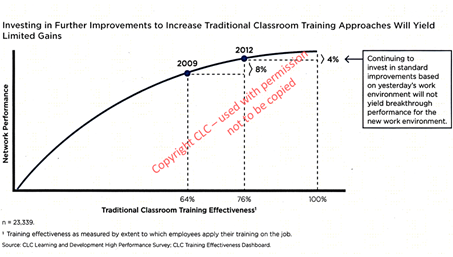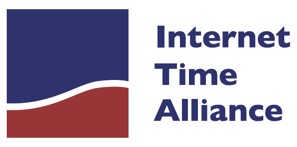 Most people get it. Classes, courses and curricula – structured learning events – don’t provide all the tools in the toolkit.
Most people get it. Classes, courses and curricula – structured learning events – don’t provide all the tools in the toolkit.
They’re bit-players in a much larger world of organisational learning and performance.
The part that formal, directed learning plays in overall organisational capability may be important at times, but organisations aspiring towards Peter Senge’s ‘learning organization’ – in other words, creating a culture of continuous learning – need to reach beyond simply improving structured training.
In a recent webinar I discussed with participants some very interesting data from the Corporate Leadership Council’s ‘Training Effectiveness Dashboard’ study. This research was part of the Corporate Executive Board’s ‘Building High Performance Capability for the New Work Environment’ report published towards the end of 2012.
The CEB study was particularly focused on ‘network performance’ – the outcomes achieved not alone, but with and through others. This is the way most work gets done.
This is the ‘20’ part of the 70:20:10 model.
The study involved more than 35,000 employees at more than 40 organisations, and CLOs were interviewed at 122 organisations.
There were three clear findings:
1. There is widespread agreement amongst senior executives, line managers and HR directors that ‘breakthrough performance’ is needed to meet immediate business goals. The average performance uplift needed to meet business goals was determined to be between 20-25% in the next 12 months.
2. ‘What got us here won’t get us there’. In other words, simply improving traditional training approaches – even introducing learning technologies into the classroom model – will not achieve the improvements needed.
A diagram from the study (below) illustrates this second point. Although the effectiveness of classroom training is seen as having improved, further improvements will not close the ‘breakthrough performance’ gap.

3. Organisations will only achieve ‘breakthrough performance’ and achieve their business goals when employees go beyond individual task performance and demonstrate high ‘network performance’. In other words, we need to plan and work not only at building individual capability, but also team and collaborative and co-operative capabilities.
To achieve these three targets we need to think out of the traditional learning and development box – beyond the class/course and eLearning module approaches towards embedding a culture where learning becomes recognised as occurring within the workflow.
Then we need to adopt and implement effective strategies to get us there.
Example: Re-thinking On-boarding Training
On-boarding and induction programmes are usually fertile ground for structured learning. They have always been seen as as essential. Yet even this ‘sacred cow’ of formal training is being challenged with some companies updating on-boarding processes and, instead of hours or days of classroom induction, are providing new recruits with tablets stuffed with helpful information and access to resources such links to expert locators on intranets and repositories of stories to help new employees navigate the networks and alcoves of their new organisation or new role within their existing organisation.
Qualcomm’s ‘52 week’s’ programme is an excellent example of this approach – enhancing or replacing intensive away-from-work on-boarding with information and resources ‘injected’ into the workflow. The 52 Weeks program initially started as a way to communicate company culture and values to new employees. Each new employee was registered to receive a weekly story by email. These stories are submitted by employees across the company and co-ordinated by the employee communications team, which reports to the Qualcomm Learning Center. It is now used across the company, not just for new employees.
This is a great initiative, but approaches such as this need to be encapsulated within a clear strategy that encourages and supports the development of a culture of continuous learning.
Concepts, Contexts and Tasks
One way of thinking about the weighting of structured training against workplace and social approaches for on-boarding is to consider what is needed to to help someone get up-to-speed in their new role. I first encountered this some years ago when working with business process guidance specialists at Panviva, an Australian company working in the performance support area.
This is where the 70:20:10 framework helps. We can think of three aspects of building capability.
1. The Concepts – answers to questions such as:
- What is expected of me in this role?
- How can I go about finding the best sources of information to help me?
- What are the core organisational principles I need to apply in my work?
2. The Context – answers to questions such as:
- What processes does someone in my role need to follow?
- How do I escalate problems if I can’t fix them?
- Who do I escalate to in specific instances?
3. The Tasks – answers to questions such as:
- What are the detailed steps to assemble this device/construct this spreadsheet model/help this client?
- I have an uncommon situation – what do I do next?

The diagram above shows that the ‘concept’ issues can be addressed through training if needed, but most of the ‘context’ issues and all of the ‘task’ issues are better addressed through use of personal networks, mentors, and performance support at the point-of-need. The breakdown here is roughly 10:90, or 10:20:70 – in other words, the 70:20:10 model can be applied even within an on-boarding construct.
The Bigger Picture: Beyond Content-Centric Learning
As we move beyond content-rich learning to exploit experience-rich learning in the workplace we need solid models and approaches that will help, and we need tools that will help us support a culture of continuous learning. This is where many organisations are finding the 70:20:10 model useful.
My experience is that the 70:20:10 framework provides a holistic strategic model that helps build a culture of continuous learning. It does this by helping learning professionals and their organisations focus on viable alternatives for development to the ‘10’ – structured, directed, ‘formal’ learning through courses, classes and eLearning.
By supporting and encouraging learning within the workflow, and through and with others, a culture of continuous learning will evolve – I’ve seen it happen.
 ConsultMember of the Internet Time Alliance and Co-founder of the 70:20:10 Institute, Charles Jennings is a leading thinker and practitioner in learning, development and performance.
ConsultMember of the Internet Time Alliance and Co-founder of the 70:20:10 Institute, Charles Jennings is a leading thinker and practitioner in learning, development and performance.
Charles, you’re right that most people get it. Traditional approaches to training have a role to play in organizational development but it’s an increasingly reduced role. However, while we may accept this in both L&D and the workplace, is the L&D community sufficiently skilled to create the sort of learning you suggest? My opinion: there are incidents of great work being done out there but overall people are struggling to meet the challenges of the day job too much to create transformational change in what they do.
Great article. It has helped me with understanding what I need to fix and has been a helpful start to creating a good learning system.
Great explanation Charles. And thanks araohanian – I think your comment is extremely valid and important. The lack of relevant skills and the need to just keep up with daily demands are I believe the key barriers to L&D functions wanting to adopt transformational change.
The imperative for many organisations is becoming to find executive level support for this change. Business leaders need to be convinced that investment is required to support the shift L&D has to make in order to provide the services and outcomes 70:20:10 promises. If L&D can't change then it won't be long before savvy operational business managers see the benefits of just in time information and better connected communities and start adopting solutions themselves, further marginalising L&D into the 10% space.
For some business leaders it may take a lot of convincing to accept that L&D, ie learning is actually a process – a natural outcome of doing work. And that solutions can be embedded in the workflow to enhance not just learning but business outcomes and productivity. It's a great challenge!
As a TRDV Graduate Student at Roosevelt University this article was right on point for me. Your input and insight into the effectiveness of training or lack thereof was thought provoking. Concepts, Context, and Tasks seem to be fundamental to learning and training. Focusing on experiential learning is another aspect of the article I enjoyed.
I appreciate the 70:20:10 model. There seems to be a reluctance to move to this type of model. In my experience companies continue to drive online training that is mostly content rich but lacks context and tasks that are based on experiential learning practices. We seem to stuck in a situation that promotes pushing out training to meet an immediate demand or as means and or manner to cut costs.
I am not confident that there are enough forward thinkers in Corporate America or Institutions to make a transformation to a solid 70:20:10 model. Making a transformation like this takes a great deal of commitment from leadership. The challenges that I have seen are related to time constraints and cost. It has to be viewed as more of investment than a cost in order to make the commitment needed to transform.
I booked marked your site and look forward to seeing more good information, ideas, and insight here.
Thanks,
Marty
As a TRDV Graduate Student at Roosevelt University this article was right on point for me. Your input and insight into the effectiveness of training or lack thereof was thought provoking. Concepts, Context, and Tasks seem to be fundamental to learning and training. Focusing on experiential learning is another aspect of the article I enjoyed.
I appreciate the 70:20:10 model. There seems to be a reluctance to move to this type of model. In my experience companies continue to drive online training that is mostly content rich but lacks context and tasks that are based on experiential learning practices. We seem to stuck in a situation that promotes pushing out training to meet an immediate demand or as means and or manner to cut costs.
I am not confident that there are enough forward thinkers in Corporate America or Institutions to make a transformation to a solid 70:20:10 model. Making a transformation like this takes a great deal of commitment from leadership. The challenges that I have seen are related to time constraints and cost. It has to be viewed as more of investment than a cost in order to make the commitment needed to transform.
I booked marked your site and look forward to seeing more good information, ideas, and insight here.
Thanks,
Marty
I am also a Graduate Student at Roosevelt University. I am fortunate enough to work for a company that promotes this model actively with employees at all levels. This does also provide a challenge for me in that I have to help employees see the bigger picture of 70 and 20 to apply in their daily lives.
I found your discussion of onboarding especially poignant. We recently developed training to help all managers understand how critical this process is and that it goes far beyond functional training. Thank you for the additional insight.
We have a culture of 'TALK' at ClarkMorgan Ltd which stands for 'Tell, Ask, Listen, and Know'. This encourages our staff to take ownership of their own learning. Staff are not allowed to say 'I don't know' or 'nobody told me'. Likewise, people are not allowed to say 'I already told'.
We have such a varied and imature culture within our organisation that it is difficult to pinpoint the exact medium used to roll out change. In most cases it is left to the functional management to develop their own programmes which can be good or bad depening on the capability of that particular silo.
Great article – thought provoking.